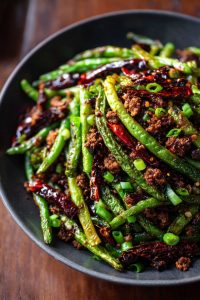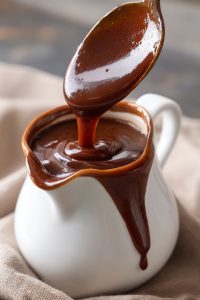Aromatic wok hei and fiery Sichuan peppercorns transport me instantly to Chengdu’s bustling night markets, where this iconic dish sizzles on every street corner. Across the Pacific in American kitchens, we can recreate that magical dry-frying technique that transforms humble green beans into crave-worthy morsels with blistered skins and tender-crisp interiors. This recipe captures the essence of Chinese culinary artistry where texture becomes as important as flavor itself.
Why This Recipe Works
- The dry-frying technique creates beautifully blistered skins while maintaining a satisfying crunch, mimicking the texture achieved in professional Chinese restaurant woks
- Sichuan peppercorns provide that distinctive ma la sensation—both numbing and spicy—that defines authentic Sichuan cuisine and creates an unforgettable flavor experience
- High-heat cooking locks in the beans’ vibrant green color while developing complex caramelized notes through the Maillard reaction
- The combination of ground pork and preserved vegetables adds umami depth that balances the beans’ natural sweetness
- Using both light and dark soy sauces creates layered saltiness and color that professional Chinese chefs swear by
Ingredients
- 1 pound fresh green beans, ends trimmed and cut into 2-inch pieces
- 4 ounces ground pork (80/20 blend recommended)
- 3 tablespoons Sichuan preserved vegetables (zha cai), rinsed and finely chopped
- 4 cloves garlic, minced
- 1 tablespoon fresh ginger, grated
- 2 teaspoons Sichuan peppercorns, lightly toasted and ground
- 1-2 dried red chilies, broken into pieces (adjust to heat preference)
- 2 tablespoons vegetable oil (peanut or canola preferred)
- 1 tablespoon light soy sauce
- 1 teaspoon dark soy sauce
- 1 teaspoon Shaoxing wine
- 1/2 teaspoon sugar
- 1/4 teaspoon white pepper
- 2 scallions, thinly sliced for garnish
Equipment Needed
- 14-inch carbon steel wok or large cast-iron skillet
- Wok spatula or sturdy metal spatula
- Large baking sheet or plate for blanched beans
- Small bowls for mise en place
- Spice grinder or mortar and pestle
- Kitchen thermometer (optional but helpful)
Instructions

Prepare and Blanch the Green Beans
Begin by bringing a large pot of heavily salted water to a rolling boil—the water should taste like the sea, which ensures proper seasoning penetrates the beans’ thick skins. While waiting, prepare an ice bath in a large bowl with equal parts ice and cold water. Carefully drop the trimmed green beans into the boiling water and cook for exactly 90 seconds, until they turn bright emerald green but remain quite firm. Immediately transfer them using a spider strainer or slotted spoon into the ice bath to halt the cooking process, preserving that vibrant color and crisp texture. Drain thoroughly and pat completely dry with paper towels—this step is crucial for achieving proper blistering later. The blanching process not only sets the color but also tenderizes the outer layer while maintaining structural integrity.
Toast and Grind Sichuan Peppercorns
Place your Sichuan peppercorns in a dry wok or skillet over medium-low heat and toast for 2-3 minutes, shaking the pan constantly until they become fragrant and slightly darkened. You’ll know they’re ready when the citrusy, pine-like aroma fills your kitchen—be careful not to burn them as they can turn bitter. Transfer the toasted peppercorns to a spice grinder or mortar and pestle, grinding until you achieve a coarse powder with some larger pieces remaining for textural interest. Sift through a fine-mesh strainer to remove any hard stems or seeds that might remain. This freshly ground peppercorn will provide that characteristic ma la sensation far superior to pre-ground versions, which lose their aromatic oils quickly.
Stir-Fry the Aromatics and Pork
Heat your wok over high heat until smoking hot, then add the vegetable oil and swirl to coat the surface. Immediately add the ground pork, breaking it up with your spatula and cooking until it loses its pink color and begins to brown—about 3-4 minutes. The pork should develop some crispy edges while remaining tender. Push the pork to one side of the wok and add the minced garlic, grated ginger, and dried chili pieces, stirring constantly for just 30 seconds until fragrant but not burned. Then incorporate the Sichuan preserved vegetables, cooking for another minute until their salty, pungent aroma melds with the other ingredients.
Dry-Fry the Green Beans to Perfection
Develop the Sauce and Final Seasoning
Push all ingredients to the sides of the wok, creating a well in the center. Pour in the Shaoxing wine—it should immediately sizzle and reduce by half within 15 seconds. Then add both soy sauces, sugar, and white pepper directly into this hot spot, allowing them to caramelize slightly before mixing everything together thoroughly. Sprinkle in most of your freshly ground Sichuan peppercorns, reserving some for garnish. Toss everything together for another minute until the sauce glazes the beans and pork beautifully. The beans should appear glossy but not soupy, with the sauce clinging perfectly to each piece.
Finish and Plate with Garnishes
Turn off the heat and perform one final vigorous toss to incorporate any remaining sauce. Transfer to a serving platter and immediately garnish with the sliced scallions and remaining Sichuan peppercorn powder. The residual heat will wilt the scallions slightly while preserving their fresh flavor. Serve immediately while the beans maintain their crisp-tender texture—this dish waits for no one. The contrast between the hot beans, numbing peppercorns, and fresh scallions creates a symphony of sensations that exemplifies why Sichuan cuisine has captivated global food lovers for centuries.
Tips and Tricks
For those seeking restaurant-quality results, several advanced techniques can elevate your dry-fried green beans to new heights. First, consider the bean selection—look for thinner, younger haricot verts if available, as they blister more easily and have tender skins. When blanching, adding a teaspoon of baking soda to the water can help break down the beans’ cellular structure, resulting in more dramatic blistering during the frying stage. For the dry-frying process, don’t overcrowd the wok—work in batches if necessary to ensure each bean makes contact with the hot surface. The ideal wok temperature should reach 400-450°F before adding oil, which you can test by flicking a drop of water—it should vaporize instantly. Many Chinese chefs use a technique called “passing through oil” where beans are briefly deep-fried instead of blanched, creating incredible blistering but requiring more oil and careful temperature control around 375°F. For the pork component, try using ground pork belly instead of regular ground pork for richer flavor and better texture. When working with Sichuan peppercorns, toasting them twice—once whole and again after grinding—can intensify their aromatic qualities. For those sensitive to the numbing sensation, you can toast the peppercorns longer to mellow their effect or use only the fragrant outer husks after sifting. The preserved vegetables (zha cai) can vary in saltiness between brands, so always taste and adjust soy sauce accordingly. If you can’t find zha cai, Korean salted radish (danmuji) makes an acceptable substitute. For maximum wok hei, some chefs drizzle a teaspoon of hot oil around the edges of the wok just before serving to create a final burst of aroma. Leftovers reheat surprisingly well in a hot skillet rather than microwave to maintain texture. Finally, consider serving with a small dish of Chinese black vinegar for dipping—the acidity provides a lovely counterpoint to the rich, numbing flavors.
Recipe Variations
- Vegetarian Delight: Replace the ground pork with crumbled firm tofu or textured vegetable protein soaked in soy sauce and mushroom powder. Add shiitake mushrooms sautéed until crispy for umami depth, and include a tablespoon of fermented black beans (douchi) for that authentic Chinese flavor profile. The cooking technique remains identical, but you might want to increase the oil slightly since tofu lacks natural fats.
- Thai Fusion Twist: Incorporate Southeast Asian flavors by replacing Sichuan peppercorns with Thai bird’s eye chilies and adding a tablespoon of Thai basil during the final toss. Include a teaspoon of fish sauce along with the soy sauces, and garnish with crushed peanuts and fresh cilantro. The result is a vibrant cross-cultural creation that maintains the textural excellence of dry-frying while introducing bright, herbal notes.
- Korean Gochujang Version: For those who love Korean cuisine, substitute the dried chilies with 2 tablespoons of gochujang paste and add 1 teaspoon of gochugaru (Korean chili flakes). Include thinly sliced Korean rice cakes (tteok) during the dry-frying stage for chewy contrast, and finish with sesame seeds and perilla leaves. The sweet-spicy profile of gochujang creates a completely different but equally addictive experience.
- American Comfort Food Adaptation: Transform this into a main dish by adding diced potatoes that have been par-cooked and browned alongside the beans. Include sliced smoked sausage instead of ground pork, and reduce the Sichuan peppercorns to just a pinch for approachable heat. Serve over rice as a complete meal that introduces Chinese techniques to familiar American ingredients.
- Seafood Upgrade: For coastal variations, use chopped shrimp or scallops instead of pork, adding them later in the cooking process to prevent overcooking. Include dried shrimp for extra umami punch, and finish with a squeeze of fresh lime juice. The briny sweetness of seafood pairs wonderfully with the numbing heat of Sichuan peppercorns.
Frequently Asked Questions
Can I use frozen green beans instead of fresh?
While fresh beans are ideal for achieving the characteristic blistered texture, frozen green beans can work in a pinch with adjustments. Thaw completely and pat extremely dry—even more than fresh beans—as excess moisture is the enemy of proper blistering. You may need to increase cooking time by 2-3 minutes to drive off additional water content. The texture will be slightly softer than fresh beans, but the flavor profile remains satisfying. Some cooks even prefer frozen for convenience, though traditionalists argue the cell structure changes during freezing affect the final mouthfeel. If using frozen, consider the French-cut style which exposes more surface area to the hot wok.
What if I can’t find Sichuan peppercorns?
Sichuan peppercorns contribute the signature ma la (numbing-spicy) quality that defines this dish, but several substitutes can approximate the experience. Black peppercorns mixed with a pinch of citrus zest provide the aromatic heat without the numbing sensation. For closer approximation, try combining equal parts black pepper, coriander seeds, and a small amount of star anise powder. Some Asian markets sell “Sichuan pepper salt” blends that work well. If you simply omit them entirely, increase the dried chilies slightly and add a teaspoon of five-spice powder to maintain complexity. The dish will still be delicious, just missing that distinctive tingling sensation.
How do I achieve proper wok hei without a professional wok burner?
Home cooks can approximate wok hei—that smoky “breath of the wok” flavor—through several techniques. First, ensure your home stove is at absolute maximum heat for at least 5 minutes before cooking. Use a cast-iron skillet if your wok doesn’t sit properly on your burner. The key is creating a small flare-up by adding a teaspoon of oil around the edge of the hot wok just before adding ingredients—this brief combustion creates complex flavors. Some chefs drizzle a teaspoon of Shaoxing wine down the hot sides for similar effect. Cooking in smaller batches prevents temperature drop, and preheating your serving plate helps maintain temperature. While not identical to professional results, these methods produce remarkably close approximations.
Can I make this dish ahead of time for a dinner party?
This dish is best served immediately, but with strategic prep you can minimize last-minute work. Blanch the green beans up to 4 hours ahead and store them spread on paper towels in the refrigerator. Prepare all aromatics, sauce ingredients, and ground pork mixture separately, keeping them refrigerated until cooking. The actual stir-frying process should take no more than 10 minutes from start to finish when everything is prepped. If you must make it completely ahead, reheat in a very hot wok or skillet rather than microwave to restore texture. The beans will soften slightly but remain delicious. For large gatherings, consider setting up a station and cooking batches throughout the event.
What’s the difference between dry-frying and regular stir-frying?
Dry-frying (gan bian) is a specific Sichuan technique where ingredients are cooked in minimal oil over extended contact with the hot wok surface, creating concentrated flavors and distinctive texture. Unlike regular stir-frying where ingredients move constantly, dry-frying involves letting ingredients sit against the hot surface to develop blisters and slight char. The process typically takes longer—5-8 minutes versus 2-3 for stir-frying—and uses less sauce, resulting in a drier final dish. Dry-frying emphasizes texture development through Maillard reaction and dehydration, while stir-frying focuses on quick cooking with ample sauce. Many Sichuan dishes employ both techniques sequentially for layered complexity.
Summary
This Sichuan dry-fried green beans recipe transforms simple ingredients through masterful technique into an unforgettable culinary experience. The blistered beans, numbing peppercorns, and savory pork create textural and flavor harmony that exemplifies why Sichuan cuisine continues to captivate global palates. Perfect as side or main dish.



